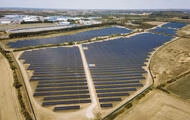How Is Jaguar Land Rover Using Solar Power to Transform Its Headquarters?
Imagine standing on a field the size of 36 football pitches, all shimmering with solar panels. That’s exactly what you’d see at Jaguar Land Rover’s (JLR) Gaydon headquarters right now. The company has just flipped the switch on a massive solar farm, marking a bold leap towards energy independence and a greener future.
What Does This Solar Farm Actually Do?
Let’s break it down. The new solar installation covers 26 hectares and boasts an impressive 18 megawatts (MW) of capacity. In plain English? It’s enough to power about a third of JLR’s entire Gaydon base, which houses their design, engineering, and R&D teams. That’s not just a token gesture—it’s a serious chunk of the company’s energy needs now coming straight from the sun.
Why Is JLR Investing So Heavily in On-Site Renewables?
Energy costs are unpredictable. Anyone who’s paid a utility bill in the last few years knows that. By generating electricity on-site, JLR isn’t just cutting its carbon footprint—it’s also shielding itself from the wild swings of the energy market. The company has set a goal: at least 30% of its global energy use should come from on-site renewables. That’s ambitious, but it’s also a smart hedge against future price hikes and supply disruptions.
How Does This Fit Into JLR’s Broader Sustainability Plans?
JLR’s solar ambitions don’t stop at Gaydon. Over in Wolverhampton, the company is putting the finishing touches on one of the UK’s largest rooftop solar arrays. With more than 18,000 panels, this setup will soon generate around 9,500 megawatt-hours (MWh) of clean energy each year—enough to meet 40% of the site’s needs. And next year, JLR plans to roll out 10MW of solar car ports at its Merseyside facility. These aren’t just for show; they’ll help power electric vehicle (EV) charging stations, making the company’s transition to electrification even cleaner.
Are These Moves Making a Real Difference?
Absolutely. According to the International Energy Agency, solar power is now the cheapest source of electricity in many parts of the world. By tapping into this, JLR is not only slashing its operational emissions but also delivering real, long-term value. Andrea Debbane, JLR’s chief sustainability officer, put it plainly: these steps are crucial for hitting net zero targets and making a difference right now—not just in some distant future.
What Can Other Companies Learn from JLR’s Approach?
JLR’s strategy isn’t just about ticking boxes for corporate social responsibility. It’s about future-proofing the business. By investing in large-scale, on-site renewables, they’re gaining control over their energy destiny. They’re also setting an example for other manufacturers: sustainability can go hand-in-hand with innovation and operational resilience.
If you look at similar efforts in other industries, the benefits stack up quickly. For instance, a 2023 report from the UK’s Department for Energy Security and Net Zero found that companies with significant on-site renewable generation saw both lower energy bills and improved public perception. It’s not rocket science—just start small, measure the impact, and scale up.
What’s Next for JLR and Renewable Energy?
The momentum is clear. With solar farms, rooftop arrays, and solar car ports all coming online, JLR is building a blueprint for how legacy automakers can reinvent themselves for a low-carbon world. The outcome? Game-changing. Not just for the company, but for the entire industry.
As more organizations face pressure to cut emissions and stabilize costs, JLR’s example shows that bold, practical investments in renewables aren’t just good for the planet—they’re good for business, too. If you’re wondering whether this approach is worth it, just look at the numbers and the growing list of benefits. The sun is shining on JLR’s future, and it’s a lesson others would do well to follow.

